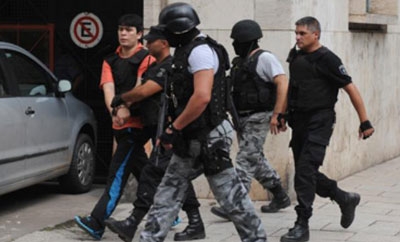The prosecution of 35 members of the Rosario-based Los Monos drug gang has provided an inside look at a sophisticated operation that has infiltrated state structures and appears to be involved in drug production, in one example of Argentina’s evolving organized crime landscape.
The case is a result of investigations that began in September 2012 following the murder of Martin Paz, alias “Fantasma,” a member of Los Monos who fellow members accused of using the gang’s money to start his own drug business in Rosario, reported La Nacion. Paz bought 80 kilos of coca paste in Bolivia to process in Rosario, but the drugs were seized en route by Argentine authorities.
Among those being prosecuted are the son of a leader of the group, Ariel Maximo Cantero, and the representative of Buenos Aires soccer player Angel Correa, whose links with the gang came under investigation last year. Eleven members of the Santa Fe provincial police, a federal police agent and a member of the navy are also accused of ties to the group, reported Clarin.
Los Monos is run by the Cantero clan. The two main leaders, Ariel Cantero and Ramon Machuca, have been on the run for nearly a year. The group’s structure includes a network of hired assassins and money launderers, and the gang operates with the protection of corrupt police. In addition to micro-trafficking, the gang is involved in extortion, money laundering and the sale of private security services, according to Clarin.
The gang members are currently being processed for illicit association, but the case is set to be brought to federal courts so they can be tried for drug-related crimes.
InSight Crime Analysis
Los Monos’ ability to draw in corrupt police, involvement in drug production and multi-layered structure are all signs of a sophisticated operation, and are representative of a general evolution taking place in Argentina’s drug trade. Once a cocaine transit nation and major consumer market, Argentina has now become a center of production for Mexican cartels, and the country’s street level drug trade has also evolved.
SEE ALSO: Coverage of Criminal Migration
Rosario is the city that has most strongly felt this change. Lying at the end of the Ruta 34 highway — a major transit route for moving cocaine from Bolivia to Argentine cities — it has become a hub both for drug trafficking and production, with the country’s biggest cocaine factory yet discovered nearby last year.
Fighting between Los Monos and other drug gangs for control over the local drug market, has caused Rosario’s homicide rate to soar. Last year saw a record number of homicides in Rosario, with 264 registered killings — 76 percent more than in 2012. As the gangs have grown, they have also begun to use methods typical of larger groups, including the intimidation of political figures and the employment of “sicario” (hitman) networks.

